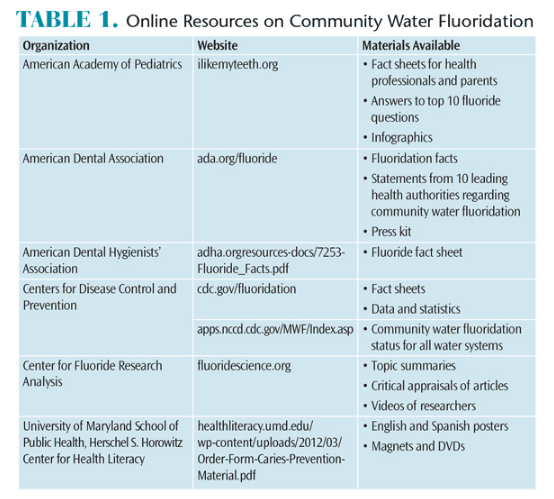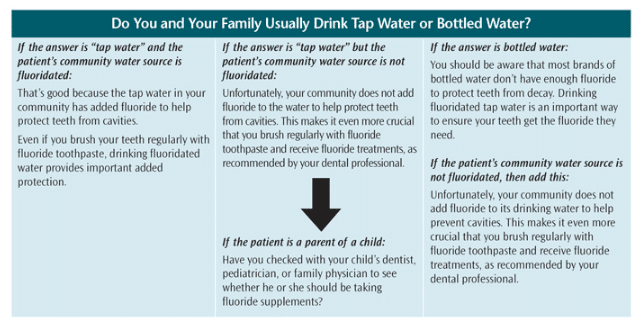
Sharing Facts About Fluoride
Dental hygienists need to be prepared to promote and defend community water fluoridation as an effective caries-prevention strategy.
Dental caries is the most prevalent chronic disease of childhood.1 While the overall prevalence of tooth decay has declined over the past few decades, early childhood caries (ECC) still affects more than 1.5 million children younger than 6 in the United States.1 Caries also disproportionately affects minority and economically disadvantaged populations, especially individuals eligible for Medicaid.1 Community water fluoridation is an effective means of reducing caries among diverse populations. It is supported by most major health organizations, including the US Centers for Disease Control and Prevention, World Health Organization, American Dental Association, American Dental Hygienists’ Association, American Academy of Pediatric Dentistry, American Medical Association, and American Academy of Pediatrics.
Almost all water supplies naturally contain fluoride.2 Community water fluoridation is simply the adjustment of the natural concentration of fluoride to a level that is optimal for preventing dental caries. Research has consistently shown that community water fluoridation reduces the incidence of tooth decay.3,4 Fluoridation of community water supplies benefits everyone in the community regardless of age, race, income, or insurance status. Even with widespread use of fluoride toothpaste, mouthrinse, and professional fluoride treatments, community water fluoridation has been shown to reduce dental caries by an additional 25% over an individual’s lifetime.5
Anti-fluoride activists—despite the large body of evidence demonstrating the success of community water fluoridation in reducing tooth decay—continue to fight against such programs. More than 200 jurisdictions—from Georgia to Alaska—have stopped adding fluoride to their community water supplies.6 Dental professionals are charged with educating patients and their communities about the efficacy of community water fluoridation in order to ensure the continued viability of this important public-health initiative.
COUNTERACTING FLUORIDE MISINFORMATION
Communities across the US are electing to discontinue water fluoridation. In New York alone, 15 communities have contacted the New York State Department of Health over the past 3 years about eliminating their community water fluoridation programs, with three voting to discontinue it. Myths and confusion about the safety and efficacy of fluoridation have prompted local officials to openly question its need. Decades ago, people were likely to pose questions or concerns about fluoride to their dentist or dental hygienist. Today, however, people often research their fluoridation questions on the Web. The Pew Internet Project found that 72% of Internet users said they searched online for health information over the past year.7 Unfortunately, the Internet contains a wealth of misleading information on this and other topics. As a result, oral health practitioners must take a proactive approach and start routine chairside conversations about the science behind fluoride and fluoridation in clear, concise messages.
NEW YORK TAKES ACTION
In New York, more than 45% of third-grade children experience dental caries.8,9 In order to improve its residents’ oral health, the Department of Health developed “The Prevention Agenda 2013-2017: New York State’s Health Improvement Plan.” The plan identified the expansion of community water fluoridation as a priority public-health measure, with emphasis placed on clinicians to “stress benefits of fluoridation to patients in dental offices and health clinics.”10,11
The Department of Health partnered with the New York State Dental Foundation, Children’s Dental Health Project, and Orange County Community College Department of Dental Hygiene to develop “Community Water Fluoridation: A Chairside Guide for Dental Hygienists.”12 The chairside guide trains dental hygienists to effectively communicate with patients about community water fluoridation in a nonconfrontational manner.
A continuing education (CE) course was also developed to train dental hygienists on issues related to fluoridation. The course focuses on the evidence-based science behind fluoridation and reviews the two most recent changes in the recommendations for fluoride use. These include the proposed change in the level of fluoride in drinking water to 0.7 milligrams per liter by the US Department of Health and Human Services due to an increase in fluoride sources (eg, toothpaste, topical dental products, packaged foods, and juices) and guidelines for appropriate use of toothpaste among young children (a smear for children younger than 3; a pea-sized amount for children ages 3 to 6).13,14 During the course, participants are split into groups to accomplish the following objectives: practice answering commonly asked questions about community water fluoridation and fluoride use; learn how to teach patients to access accurate scientific information on the Internet; practice using the chairside guide to facilitate effective face-to-face patient interactions; and understand how to support community water fluoridation initiatives.
The CE course was initially presented to 66 dental hygienists in August 2014 at Orange County Community College in Newburgh, New York, and at Monroe Community College in Rochester, New York. Participants received a copy of the chairside guide, the PowerPoint presentation, several resource cards, and instructions on how to obtain the fluoridation status of communities. The resource cards contained information on how to obtain reliable, evidence-based information about fluoride and fluoridation (Table 1). The participants were encouraged to distribute these to their patients. Participants also received a flash drive with additional resources. Course evaluations noted that 100% of participants would recommend this course to others. A modified version of the CE course was also presented as a webinar in late August 2014.
The goals of the chairside guide and CE course are to encourage dental hygienists to proactively initiate dialogue with patients as part of oral health education and to provide core prevention messages on fluoride use, including the importance of drinking fluoridated water to reduce caries risk. This conversation can be easily initiated by asking patients about their drink choices and promoting tap water as the healthiest, most economical, and ecofriendly choice. By starting with this question, the conversation can lead directly into a discussion of fluoridated tap water (Figure 1).

EXPANSION OF THE CHAIRSIDE GUIDE MODEL
Based on the success of the first two CE courses, the program will expand throughout the state of New York in 2015. The target audience will remain dental hygienists because of their pivotal role as preventive specialists. The chairside guide and CE course can easily be modified for dentists, mid-level providers, dental assistants, or other members of the dental team.
For dental hygienists interested in replicating this program, a team of experts should be assembled to develop or modify the chairside guide and training protocol. The team should include representatives from the state dental and dental hygiene associations, oral health coalitions, academic institutions or residency programs, local or state health departments, and organizations supporting local fluoridation initiatives. All concerns regarding community water fluoridation in a community or state should be assessed as a team and then incorporated into the new material. This model also can fit other health interventions, including smoking cessation, healthy eating, and topical fluoride use.
CONCLUSION
Dental hygienists are at the forefront of prevention, patient education, and advocacy, and patients look to them for health-related information. As such, guidance on community water fluoridation should be integrated into the prevention messages dental hygienists provide to patients. Oral health professionals need to remain up-to-date on the evidence-based science regarding the benefits of fluoride use and water fluoridation programs so they can serve as key resources for both patients and their communities. As the anti-fluoridation movement continues to spread inaccurate information, dental hygienists need to be prepared to promote and defend fluoridation as a community-based prevention strategy.15 Dental professionals can also reach out to elected officials, build community partnerships, and present the facts about fluoridation to lay audiences. These strategies are key to ensuring the long-term viability of community water fluoridation and its role in reducing caries rates.
ACKNOWLEDGEMENT
The “Community Water Fluoridation: A Chairside Guide for Dental Hygienists” project was made possible by a grant from the US Health Resources and Services Administration.
REFERENCES
- American Academy of Pediatric Dentistry. Early Childhood Caries. Available at: mychildrensteeth.org/assets/2/7/ECCstats.pdf. Accessed January 26, 2015.
- Centers for Disease Control and Prevention. Community Water Fluoridation. Available at: cdc.gov/fluoridation/faqs. Accessed January 26, 2015.
- McDonagh MS, Whiting PF, Wilson PM, et al. Systematic review of water fluoridation. BMJ. 2000;321:855–859.
- Yeung CA. A systematic review of the efficacy and safety of fluoridation. Evid Based Dent. 2008;9:39–43.
- Centers for Disease Control and Prevention. Fluoridation Basics. Available at: cdc.gov/fluoridation/basics. Accessed January 26, 2015.
- Alvarez L. Looking to Save Money, More Places Decide to Stop Fluoridating the Water. New York Times. October 13, 2011.
- Pew Research Center. Health Fact Sheet. Available at: pewinternet.org/fact-sheets/health-fact-sheet. Accessed January 26, 2015.
- Centers for Disease Control and Prevention. Health, United States, 2009: With Special Feature on Medical Technology. Available at: cdc.gov/nchs/data/hus/ hus09.pdf. Accessed January 26, 2015.
- New York State Department of Health. Percentage of 3rd grade children with caries experience. Available at: health.ny.gov/statistics/chac/general/g84.htm. Accessed January 26, 2015.
- New York State Department of Health. New York State Prevention Agenda: Promoting Healthy Women, Infants and Children Action Plan. Available at: health.ny.gov/prevention/prevention_agenda/2013-2017/docs/healthy_ women_children_infants.pdf. Accessed January 26, 2015.
- New York State Department of Health. New York State Prevention Agenda: Promote a Healthy and Safe Environment Action Plan. Available at: health.ny.gov/ prevention/prevention_agenda/2013-2017/docs/healthy_environment.pdf. Accessed January 26, 2015.
- New York State Department of Health, Children’s Dental Health Project, Orange County Community College Department of Dental Hygiene, New York State Dental Foundation. Community Water Fluoridation: A Chairside Guide for Dental Hygienists. Albany, New York: New York State Department of Health; 2014.
- United States Department of Health and Human Services. Proposed HHS Recommendation for Fluoride Concentration in Drinking Water for Prevention of Dental Caries. Available at: federalregister.gov/articles/2011/01/13/2011-637/proposed-hhs-recommendation-for-fluoride-concentration-in-drinking-water-for-prevention-of-dental. Accessed January 26, 2015.
- American Dental Association Council on Scientific Affairs. Fluoride toothpaste use for young children. J Am Dent Assoc. 2014;145:190–191.
- Rainchuso L. Defenders of community water fluoridation. Dimensions of Dental Hygiene. 2014;12(2):41–43.
From Dimensions of Dental Hygiene. February 2015;13(2):40,42–43.

